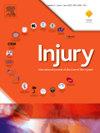Surgical treatment of infectious severe calcaneal bone defects in children by the Ilizarov technique
IF 2.2
3区 医学
Q3 CRITICAL CARE MEDICINE
Injury-International Journal of the Care of the Injured
Pub Date : 2025-02-20
DOI:10.1016/j.injury.2025.112224
引用次数: 0
Abstract
Introduction
The soft tissue of the heel is weak, and calcaneal bone defects occur easily post-infection, resulting in the inability of paediatric patients to walk normally. Calcaneal reconstruction is challenging. We aimed to evaluate the methodology and clinical effects of the Ilizarov technique in the treatment of calcaneal infectious bone defects.
Methods
We retrospectively analyzed the cases of 12 children with infectious calcaneal bone defects treated by the Ilizarov technique in our center from January 2018 to August 2022.Stump lengthening of the calcaneus was performed in nine cases. Due to severe calcaneus infection the calcaneus was removed, and talus lengthening was performed in three children. Two children were treated with drug-loaded spacer bone cement to control peripheral soft tissue infection before bone elongation could be performed, while the other ten cases underwent bone lengthening at one stage after radical debridement. Pain, foot function, self-care ability and hind foot function were evaluated using a Visual Analogue Scale (VAS), the Maryland Foot Score, Activity of Daily Living scale, and the American Orthopaedic Foot and Ankle Society retro ankle foot score.
Results
In this cohort of 12 children, the time for bone lengthening ranged from 32 to 64 days (mean 41.75 ± 10.09 days), and the distance of bone lengthening was between 2.6 cm and 5.4 cm (mean 3.57 ± 0.86 cm). The inflammation indicators CRP, ESR, and IL-6 were significantly reduced after radical debridement (15.72 ± 3.09 vs 6.04 ± 1.28, 25.20 ± 2.72 vs 15.11 ± 1.56, 16.39 ± 3.75 vs 2.99 ± 1.08, respectively; p < 0.01). Bone reconstruction effectively reduced pain in the affected limb and significantly improved foot function, self-care ability, and hind foot function in these children. In four cases, external fixators were removed and an Achilles tendon lengthening operation was performed to further reconstruct calcaneal bone function. After surgical treatment, all the children in this cohort were able to return to normal life.
Conclusion
The Ilizarov technique for treating large infectious calcaneal bone defects and bone lengthening can effectively reconstruct the function of the calcaneal bone without significantly affecting the ankle joint.
Ilizarov技术治疗儿童感染性重度跟骨缺损
脚后跟软组织软弱,感染后容易发生跟骨缺损,导致儿科患者无法正常行走。跟骨重建具有挑战性。我们旨在评估Ilizarov技术治疗跟骨感染性骨缺损的方法和临床效果。方法回顾性分析2018年1月至2022年8月我中心采用Ilizarov技术治疗的12例感染性跟骨缺损患儿。9例行跟骨残端延长术。由于严重的跟骨感染,我们切除了跟骨,并对3名患儿进行了距骨延长手术。2例患儿采用载药间隔骨水泥控制外周软组织感染后再行骨延长术,另外10例患儿在根治性清创后一期行骨延长术。采用视觉模拟量表(VAS)、马里兰足部评分、日常生活活动量表和美国骨科足踝协会复古踝足评分评估疼痛、足部功能、自我护理能力和后足功能。结果本组12例患儿的骨延长时间为32 ~ 64天(平均41.75±10.09天),骨延长距离为2.6 ~ 5.4 cm(平均3.57±0.86 cm)。根治性清创后炎症指标CRP、ESR、IL-6明显降低(15.72±3.09 vs 6.04±1.28,25.20±2.72 vs 15.11±1.56,16.39±3.75 vs 2.99±1.08);p & lt;0.01)。骨重建有效地减轻了患肢疼痛,显著改善了这些儿童的足功能、自理能力和后脚功能。在4例患者中,我们拆除了外固定架并进行了跟腱延长手术以进一步重建跟骨功能。手术治疗后,本组患儿均能恢复正常生活。结论Ilizarov技术治疗大面积感染性跟骨缺损及骨延长可有效重建跟骨功能,且对踝关节无明显影响。
本文章由计算机程序翻译,如有差异,请以英文原文为准。
求助全文
约1分钟内获得全文
求助全文
来源期刊
CiteScore
4.00
自引率
8.00%
发文量
699
审稿时长
96 days
期刊介绍:
Injury was founded in 1969 and is an international journal dealing with all aspects of trauma care and accident surgery. Our primary aim is to facilitate the exchange of ideas, techniques and information among all members of the trauma team.

 求助内容:
求助内容: 应助结果提醒方式:
应助结果提醒方式:


